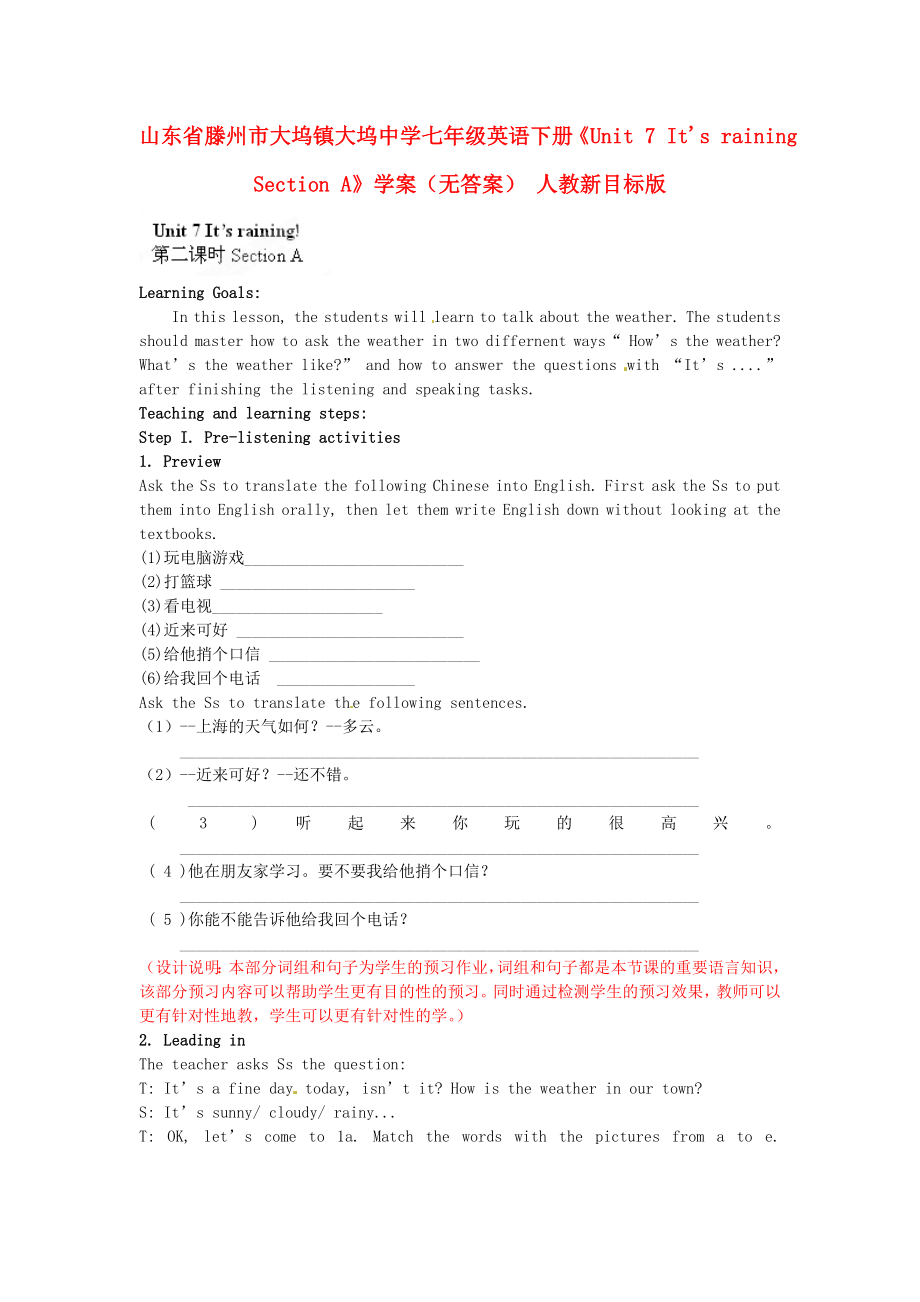《山東省滕州市大塢鎮(zhèn)大塢中學(xué)七年級(jí)英語(yǔ)下冊(cè)《Unit 7 It's raining Section A》學(xué)案(無(wú)答案) 人教新目標(biāo)版》由會(huì)員分享��,可在線閱讀���,更多相關(guān)《山東省滕州市大塢鎮(zhèn)大塢中學(xué)七年級(jí)英語(yǔ)下冊(cè)《Unit 7 It's raining Section A》學(xué)案(無(wú)答案) 人教新目標(biāo)版(4頁(yè)珍藏版)》請(qǐng)?jiān)谘b配圖網(wǎng)上搜索���。
1、山東省滕州市大塢鎮(zhèn)大塢中學(xué)七年級(jí)英語(yǔ)下冊(cè)《Unit 7 It's raining Section A》學(xué)案(無(wú)答案) 人教新目標(biāo)版
Learning Goals:
In this lesson, the students will learn to talk about the weather. The students should master how to ask the weather in two differnent ways“ How’s the weather? What’s the weather like?” and how to answer the quest
2����、ions with “It’s ....” after finishing the listening and speaking tasks.
Teaching and learning steps:
Step I. Pre-listening activities
1. Preview
Ask the Ss to translate the following Chinese into English. First ask the Ss to put them into English orally, then let them write English down without
3、 looking at the textbooks.
(1)玩電腦游戲___________________________
(2)打籃球 ________________________
(3)看電視_____________________
(4)近來(lái)可好 ____________________________
(5)給他捎個(gè)口信 __________________________
(6)給我回個(gè)電話 _________________
Ask the Ss to translate the following sentences.
(1)--上海的天氣如何��?--多云
4����、���。
________________________________________________________________
(2)--近來(lái)可好?--還不錯(cuò)��。
_______________________________________________________________
( 3 )聽(tīng)起來(lái)你玩的很高興����。________________________________________________________________
( 4 )他在朋友家學(xué)習(xí)。要不要我給他捎個(gè)口信��?
_____________________________________
5�����、___________________________
( 5 )你能不能告訴他給我回個(gè)電話�����?
________________________________________________________________
(設(shè)計(jì)說(shuō)明:本部分詞組和句子為學(xué)生的預(yù)習(xí)作業(yè)���,詞組和句子都是本節(jié)課的重要語(yǔ)言知識(shí)����,該部分預(yù)習(xí)內(nèi)容可以幫助學(xué)生更有目的性的預(yù)習(xí)。同時(shí)通過(guò)檢測(cè)學(xué)生的預(yù)習(xí)效果��,教師可以更有針對(duì)性地教���,學(xué)生可以更有針對(duì)性的學(xué)。)
2. Leading in
The teacher asks Ss the question:
T: It’s a fine day today,
6���、isn’t it? How is the weather in our town?
S: It’s sunny/ cloudy/ rainy...
T: OK, let’s come to 1a. Match the words with the pictures from a to e.
Check the answers: a, b,e,c,d
(設(shè)計(jì)說(shuō)明:讓學(xué)生將圖片中的天氣和左邊的單詞正確對(duì)應(yīng),在練習(xí)中鞏固有關(guān)短語(yǔ)天氣的詞語(yǔ)��。)
Step II. While-listening activities
1. Listen for the general idea of 1
7���、b.
The general idea of the conversatio is about________.
A. weather
B. some cities
C. the weather in some cities
2. Listen for the specific ideas of 1b
(1) Listen and write these city names in the box above.
check the answers: a: Toranto,b: Boston, c: Beijing, d: Moscow, e: Shanghai
8、(2) Complete the dialogue according to the tape.
Conversation 1:
Tom: Hi, Peter..
Peter: Hi, Tom.
Tom:How’s the _______ down there in Shanghai?
Jenny: It’s_______. How’s the weatehr in Moscow?
Tom: It’s ______ right now.
Conversation 2:
Peter: Hi, Aunt Sally.
Aunt Sally: Hello, Peter.
Pet
9�����、er: How’s the weather in Boston?
Aunt Sally: Oh, it’s______.
Conversation 3:
Peter: Hi, Uncle Bill.
Uncle Bill: Hello, Peter.
Peter: How’s the weather in Toranto?
Uncle Bill: It’s______ as usual!
3. Listen for the general idea of 2a.
The general idea of the conversatio is “________”.
A. p
10���、laying basketball
B.playing computer games
C. what Uncle Joe’s family are doing
4. Listen for the specific ideas of 2a
(1) Listen and match the pictures (1-4).
(2) Listen again. Match the names with the activities.
(設(shè)計(jì)說(shuō)明:本部分的內(nèi)容重在培養(yǎng)學(xué)生們聽(tīng)尋大意,和聽(tīng)尋細(xì)節(jié)信息的能力)
Step III. Post-listening a
11����、ctivities
1. Listen to the tape and repeat. (2c)
2. Talk about the people in 2a with a partner.(2c)
3. Play the conversation in pairs. Then go to the front of the classroom and perform it to the whole class. (2d)
4. Finish activity 3a. Fill in the blanks with the correct forms of the verbs in th
12��、e box. Then practice the conversations with a partner.
5. Fill in the chart in activity 3b.
(設(shè)計(jì)說(shuō)明:本部分的內(nèi)容重在培養(yǎng)學(xué)生的寫(xiě)作和口頭表達(dá)的能力,同時(shí)通過(guò)口頭表達(dá)引導(dǎo)學(xué)生更好地內(nèi)化語(yǔ)言知識(shí)�����。)
Step IV. Summary:Inquiry into knowledge by translation
1. How’s the weather in Beijing?
這是一個(gè)用來(lái)詢(xún)問(wèn)__________ 的句型���, How’s 是_________ 和______ 的縮寫(xiě)
2.Ho
13�����、w is it going?
這是由how 引出的問(wèn)候句式�����,用來(lái)詢(xún)問(wèn)對(duì)方的工作��,學(xué)習(xí)或生活情況����。
根據(jù)具體情況可以回答______________ 表示很好�����, _______________ 表示還不錯(cuò), ____________________表示太糟糕了�����。
3. Hello, Linda. This is Jim.
This is .... 是英語(yǔ)中________ 時(shí)的常用語(yǔ)�����, 意為_(kāi)__________,打電話時(shí)介紹自己還可以說(shuō)_____________, _________.
(設(shè)計(jì)說(shuō)明:教師要引導(dǎo)學(xué)生們運(yùn)用他們從實(shí)踐中的感知來(lái)嘗試歸納語(yǔ)言規(guī)律��,然后再給以必要幫助��。通過(guò)小
14�����、組討論的形式可獲得更為準(zhǔn)確的答案��。)
Step V. Exercises: the end-of- class test
I. Fill the blanks with the words given.
1. --What’s she doing? --She __________ (play) the guitar.
2. I usually _____ (do) my homework in the evening.
3. It _________ (rain) hard now.
4. My sister ______ (walk) to school every d
15���、ay.
5. Mr. Wu ___________ (brush) his teeth now.
6. Every Saturday, we _____ (visit) my grandparents.
7. Look! They ___________ (dance) in the classroom.
8. She never _______ (arrive) late for school.
II. Translate Chinese into English.
1.上海的天氣怎么樣?
_____________________________________
16�����、______________________
2.今天天氣晴朗。
____________________________________________________________
3. --一切都好嗎��?--還可以�����。
____________________________________________________________
4. 他正在朋友家學(xué)習(xí)��。
_____________________________________________________________
5. 我可以給他捎個(gè)口信嗎�����?
_____________________________________________________________
(設(shè)計(jì)意圖:通過(guò)檢測(cè)學(xué)生的學(xué)習(xí)情況����,有助于以學(xué)定教。)
Step VI. Homework
1. Read 2d after the tape and recite them.( ★ )
2. Suppose you are a weather reportor. Write a passage to talk about the weather in different places.( ★★ )
 山東省滕州市大塢鎮(zhèn)大塢中學(xué)七年級(jí)英語(yǔ)下冊(cè)《Unit 7 It's raining Section A》學(xué)案(無(wú)答案) 人教新目標(biāo)版
山東省滕州市大塢鎮(zhèn)大塢中學(xué)七年級(jí)英語(yǔ)下冊(cè)《Unit 7 It's raining Section A》學(xué)案(無(wú)答案) 人教新目標(biāo)版

